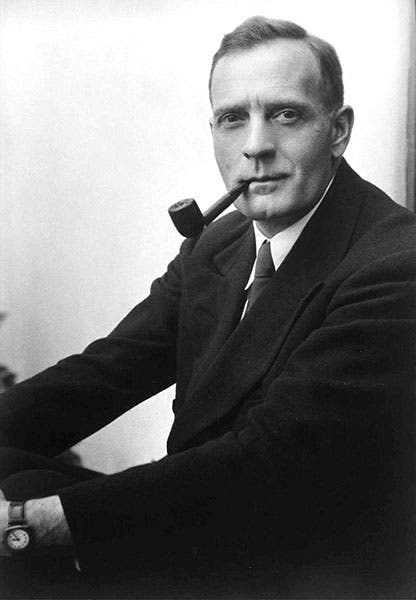Scientist of the Day - Edwin Hubble
The 100" Hooker reflecting telescope on the top of Mount Wilson, near Pasadena, California, had opened for business in 1917, and it was the world’s largest telescope for the next 32 years (first image). One of its first customers was Edwin Hubble, a 30-year-old astronomer who joined the staff at Mount Wilson in 1919 (second and fifth images). Hubble was interested in spiral nebulae, those tiny celestial swirls, the constitution of which was a complete mystery at the time. A few years earlier, Harlow Shapley at Mount Wilson, employing a 60” reflector, had measured the size of our Galaxy, using distance-indicating stars known as "Cepheid variables," and the Galactic diameter was so large (some 300,000 light-years by Shapley's over-generous initial determination) that Shapley concluded that all other objects in the visible universe, including the spiral nebulae, were within the Milky Way Galaxy. There were no external galaxies, in Shapley's opinion.
Hubble suspected from the outset that the spiral nebulae were galaxies just like the Milky Way Galaxy, but very far away, so they appeared small and, well, nebulous. He focused his attention on M31, the Great Andromeda nebula, which was the largest spiral in the sky, and thus, presumably, the closest. We include here the first detailed photograph of M31, taken by pioneer deep-sky photographer Isaac Roberts in 1888, and still one of the best before the Hooker telescope came online (third image). Hubble hoped the 100-inch telescope would yield photographs of M31 that broke the nebula down into millions of individual stars, showing it was not a nebula of gas but a galaxy of stars, and indeed some of the photographs from the 100" did seem to show individual stars. But what Hubble really needed to find was a way to measure the distance to the Andromeda nebula. If it was less than 100,000 light-years away, it was inside our Galaxy. If it was more than 300,000, then it was outside, an external galaxy of its own.
One hundred years ago today, on the night of Oct. 5/6, 1923, Hubble took a milestone photograph of M31 with the 100-inch reflector. The glass plate is labelled H335H, meaning it was the 335th plate taken by Hubble (2nd H) at the Hooker telescope (1st H) (fourth image). The first time Hubble examined the plate, he noted an unusually bright peripheral star, and he labelled it with a black marker, "N" (for nova). But in comparing this plate to others taken of the same region, he realized that the star was not a nova, but rather a variable star. So the second time he examined the plate, he crossed out the "N" and wrote in, with some enthusiasm, "VAR!" Not only was it a variable star, it was a Cepheid variable, which meant that its period of variation was a precise indicator of its distance. It turned out that the star, and thus the nebula, was almost 1 million light-years away (later to be moved out, as the Cepheid scale of distance was refined, to 2 million-light years). That meant the Andromeda nebula was truly an extra-galactic object, the Andromeda galaxy. Note that the plate is a negative, so stars are black dots, and the large dark area is the bright galactic center.
Several months later, Hubble privately announced his discovery in a letter to Shapley, by this time Director of the Harvard College Observatory, thereby ruining Shapley’s mood for a considerable length of time. Hubble continued to find other Cepheids on other photographic plates of M31, and within the year he had amassed a dozen of them. All of these pointed to a distance to M31 of around 1 million light-years. Hubble publicly announced his discovery in a paper given (in absentia) to the American Association for the Advancement of Sciences in Washington, D.C. on New Year’s Day, 1925, a paper laconically titled “Cepheids in Spiral Nebulae.” It is one of the landmark papers in the history of cosmology, the first realization that we live in a universe of galaxies, and that our Milky Way Galaxy is just one of billions of systems of stars. Thus plate H335H, which started it all, is perhaps the most renowned photographic plate in astronomical history.
H335H is one of a quarter-million photographic plates stored at the Observatories of the Carnegie Institution in Pasadena. This webpage of the Carnegie Observatories shows not only H335H, but also a plate that was taken the night before, both at several levels of contrast. H335H normally sleeps with its brethren in the plate stacks. But they bring it out every now and then for public display, and I hope they do so today.
We wrote our first post on Hubble in 2015, when we were just starting out. It was a more general post, but it does show Hubble on the cover of Time, and his bust in the state capitol building of Missouri, as well as another photo of M31 taken by the 100-inch Hooker telescope.
William B. Ashworth, Jr., Consultant for the History of Science, Linda Hall Library and Associate Professor emeritus, Department of History, University of Missouri-Kansas City. Comments or corrections are welcome; please direct to ashworthw@umkc.edu.











